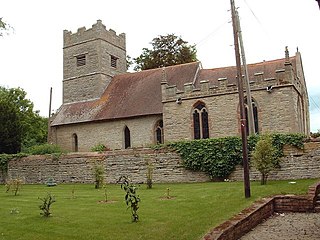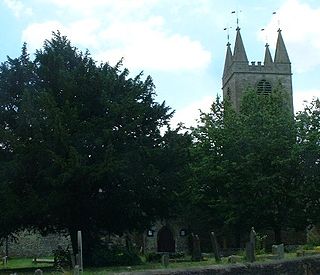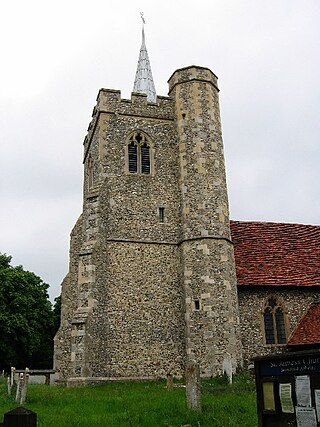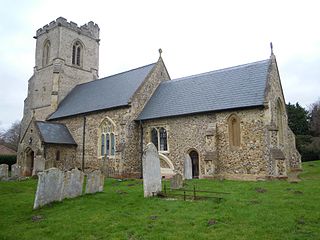
St Mary's Church is an Anglican parish church in the village of Newbold Astbury, Cheshire, England. It is recorded in the National Heritage List for England as a designated Grade I listed building, and its architecture has been praised by a number of writers.

The Church of St Michael in Shepton Beauchamp, Somerset, England is built of local hamstone, and has 13th-century origins, although it has been extensively changed since then, with major renovation in 1865 by George Edmund Street. It has been designated as a Grade I listed building.

St Andrew's Church is a redundant Church of England parish church in the village of Wroxeter, Shropshire, England. It is recorded in the National Heritage List for England as a designated Grade I listed building, and is under the care of the Churches Conservation Trust. Both the village of Wroxeter and the church are in the southwest corner of the former Roman town of Viroconium.

All Saints' Church, Spetchley, is a redundant Anglican church adjacent to Spetchley Park, Worcestershire, England. It is recorded in the National Heritage List for England as a designated Grade II* listed building, and is under the care of the Churches Conservation Trust.

The Church of St Peter in Marksbury, Somerset, England dates from the 12th century, although most of the current fabric is from the 15th century and is a Grade II* listed building.

St James' Church is a redundant Anglican church near the village of Stanstead Abbotts, Hertfordshire, England. It is recorded in the National Heritage List for England (NHLE) as a Grade I listed building, having been designated in 1967. The church is under the care of the Churches Conservation Trust. The church is about 1 mile (1.6 km) to the southeast of the village on the north side of the B181 road. It stands on the top of a hill overlooking the Lea marshes.

St Botolph's Church is a redundant Anglican church near the village of Skidbrooke, Lincolnshire, England. It is recorded in the National Heritage List for England as a designated Grade I listed building, and is under the care of the Churches Conservation Trust. It stands in an isolated position in the Lincolnshire marshlands, about 7 miles (11 km) northeast of Louth, and to the west of the A1031 road.

All Saints Church is a redundant Anglican church in the village of Little Wenham, Suffolk, England. It is recorded in the National Heritage List for England as a designated Grade I listed building, and is under the care of the Churches Conservation Trust. It stands in an isolated position close to Little Wenham Hall, about 0.6 miles (1 km) to the northwest of Capel St. Mary.

St Mary's Church is a redundant Anglican church in the civil parish of Rickinghall Superior, in the village of Rickinghall, Suffolk, England. It is recorded in the National Heritage List for England as a designated Grade I listed building, and is under the care of the Churches Conservation Trust. There are two churches serving the village of Rickinghall, both dedicated to St Mary, the other being an active parish church in the centre of the village in the parish of Rickinghall Inferior. St Mary's Church, Rickinghall Superior, stands to the south of the village, on the other side of the A143 road.

St James' Church is in the village of Brindle, Lancashire, England. It is an active Anglican parish church in the deanery of Chorley, the archdeaconry of Blackburn, and the diocese of Blackburn. The church is recorded in the National Heritage List for England as a designated Grade II listed building.

St John the Baptist's Church in the village of Allington, south-east of Amesbury in Wiltshire, England, is a redundant Anglican parish church which was rebuilt in 1851. The church is recorded in the National Heritage List for England as a Grade II listed building and has been in the care of the Friends of Friendless Churches since 2011.

All Saints Church is a parish church in Hollingbourne, Kent. It was begun in the 14th century and is a Grade I listed building. The church contains numerous monuments to the local Culpeper family.

All Saints is a parish church in Ulcombe, Kent. It was begun in the 12th century and is a Grade I listed building.

St Peter's Church is in the grounds of Cound Hall, Cound, Shropshire, England. It is an active Anglican parish church in the deanery of Condover, the archdeaconry of Ludlow, and the diocese of Hereford. Its benefice is united with those of 13 other parishes to form the benefice of Wenlock. The church is recorded in the National Heritage List for England as a designated Grade I listed building.

The Anglican Church of St Peter and St Paul in Wincanton within the English county of Somerset is a Grade II* listed building. The Church of St Peter and St Paul was almost totally rebuilt 1887-91 by J. D. Sedding, however parts of the tower may be remnants form an earlier church, dating from 1313, on the same site.

St Mary and St Peter's Church is a Grade I listed Church of England parish church dedicated to Saint Mary and Saint Peter in Harlaxton, Lincolnshire, England. The church is 2 miles (3 km) south-east from Grantham, and at the eastern edge of the Vale of Belvoir in South Kesteven.

St Piran's Church is an active Anglican parish church in Perranarworthal, Cornwall, England. It is part of a united benefice consisting of eight churches, the Eight Saints Cluster, in the parishes of Stithians with Perran-Ar-Worthal and Gwennap. The benefice has four licensed clergy and four readers. The church, dedicated to Saint Piran, is in the Carnmarth, North deanery, the archdeaconry of Cornwall and the Diocese of Truro. The church was granted Grade II* listed status in May 1967. The churchyard contains several listed chest tombs and headstones.

St Andrew and St Mary's Church is a Grade I listed Church of England parish church dedicated to Saint Andrew and Saint Mary, in the parish of Easton and the village of Stoke Rochford, Lincolnshire, England. The church is 5 miles (8 km) south from Grantham, and at the western side of the Lincolnshire Vales in South Kesteven.

St Donat's Church is a Grade I listed church in St Donats, in the Vale of Glamorgan, south Wales. It became a Grade I listed building on 22 February 1963.

The Church of All Saints is the Anglican parish church for the village of Willian in Hertfordshire. The benefice is united with St Paul's church in nearby Letchworth, although each church has its own parish. It is in the Diocese of St Albans. The church has been a Grade II* listed building since 1954.
























